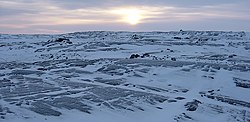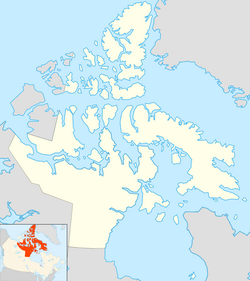Whale Cove, Nunavut
|
Whale Cove ᑎᑭᕋᕐᔪᐊᖅ Tikirarjuaq |
|
|---|---|
 |
|
| Coordinates: 62°10′22″N 092°34′46″W / 62.17278°N 92.57944°WCoordinates: 62°10′22″N 092°34′46″W / 62.17278°N 92.57944°W | |
| Country | Canada |
| Territory | Nunavut |
| Region | Kivalliq Region |
| Electoral district | Arviat North-Whale Cove |
| Government | |
| • Type | Hamlet Council |
| • Mayor | Stanley Adjuk Sr. |
| • Senior Administrative Officer | Paul Kaludjak |
| • MLA | George Kuksuk |
| Area | |
| • Total | 283.65 km2 (109.52 sq mi) |
| Elevation | 40 m (130 ft) |
| Population (2006) | |
| • Total | 250 |
| • Density | 0.88/km2 (2.3/sq mi) |
| Time zone | CST (UTC-6) |
| • Summer (DST) | CDT (UTC-5) |
| Canadian Postal code | X0C 0J0 |
| Area code(s) | 867 |
| Website | whalecove.ca |
Whale Cove (ᑎᑭᕋᕐᔪᐊᖅ in Inuktitut syllabics) (Tikiraqjuaq, meaning "long point"), is a hamlet located 45 mi (72 km) south of Rankin Inlet, 100 mi (161 km) north of Arviat, in Kivalliq Region, Nunavut, Canada, on the western shore of Hudson Bay.
The community is named for the many beluga whales which congregate off the coast. Many of the inhabitants hunt these whales every fall and use their by-products for their oil and food. Whale Cove, initially settled by three distinct Inuit groups (one inland and two coastal), is a relatively traditional community: 99% Inuit, who still wear fur, hunt, fish, eat raw meat and fish. Whale Cove is on the polar bear migration route.
Local Inuit, regularly travel by snowmobile in the winter or by boat in summer months between the hamlet of Rankin Inlet and Whale Cove a distance of 100 km (62 mi). The terrain is arctic tundra, this consists mostly of rocks, mosses and lichens.
As of the 2006 census, the population was 353, an increase of 15.7% from the 2001 census.
Inuit in the Whale Cove area traded whale oil, baleen, furs, leather and walrus tusks with the Hudson's Bay Company since the mid-18th century when the HBC established their trading post at Churchill, Manitoba.
In the 1950s and 1960s Inuit were relocated in a series of moves from one hamlet to another, some of them arriving in Whale Cove, a hamlet created by the federal government for these Inuit groups. Some came from Ennadai Lake via Arviat to Whale Cove, other came from Back River via Garry Lake then Baker Lake to Whale Cove. By the 1970s Inuit living in Whale Cove represented boast coastal Inuit from Rankin Inlet and Arviat and different Caribou Inuit, from the Barren Grounds west of Hudson Bay, including the Ihalmiut ("people from beyond"), or Ahiarmiut ("the out-of-the-way dwellers") on the banks of the Kazan River, Ennadai Lake, Little Dubawnt Lake (Kamilikuak), and north of Thlewiaza (Kugjuaq; "Big River"), had been relocated in the 1950s Whale Cove and Henik Lake. by the Department of Northern Affairs and Natural Resources (now Aboriginal Affairs and Northern Development Canada). Their hunting experience was based almost entirely on "inland caribou herds that had thinned by the 1950s and left many families hungry. Coastal dwelling Inuit from Rankin Inlet and Arviat were relocated to Whale Cove from nearby coastal communities in order to aid the inlanders in adapting to a marine subsistence economy."
...
Wikipedia

